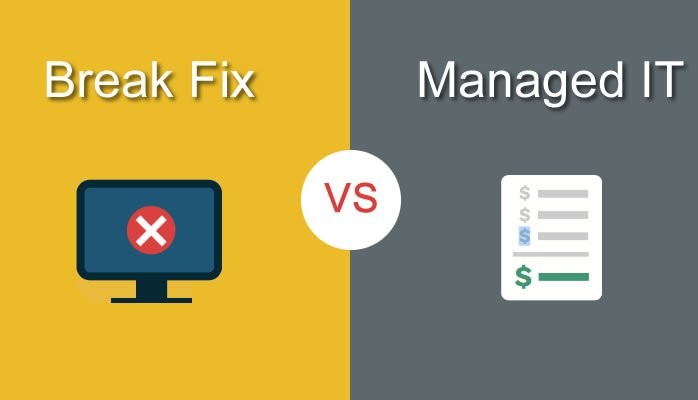Tech
Break/Fix vs Managed Service Provider (MSP): Differences
Break/Fix vs Managed Service Provider (MSP): Navigating IT Support Approaches

Break/Fix vs Managed Service Provider (MSP): Navigating IT Support Approaches
In the realm of IT support, two prominent models have emerged: the traditional Break/Fix approach and the more contemporary Managed Service Provider (MSP) model. These two approaches offer distinct ways of managing and maintaining technology infrastructure, each with its own set of advantages and considerations. Understanding the differences between Break/Fix vs MSP can help organizations make informed decisions about which approach aligns better with their IT needs and business goals.
In a rapidly evolving digital landscape, where technology underpins nearly every aspect of business operations, the advantages of the Managed Service Provider (MSP) model become increasingly evident. The proactive nature of an MSP’s services aligns well with the demands of maintaining a competitive edge. By preventing issues before they manifest as disruptions, businesses can optimize productivity and allocate resources more efficiently.
Moreover, the predictability of costs associated with the MSP model provides a level of financial stability that the Break/Fix approach often lacks. The subscription-based structure allows organizations to allocate IT budgets with greater accuracy, reducing the risk of unexpected expenses stemming from sudden breakdowns.
Collaboration is at the heart of the MSP-client relationship. MSPs become more than just technical troubleshooters; they become partners who understand an organization’s goals and help leverage technology to achieve those objectives. This approach fosters innovation and strategic thinking, as both parties work together to explore technology solutions that enhance operations, security, and growth.
Break/Fix Model:
The Break/Fix model, rooted in the reactive approach, has been a longstanding method of IT support. In this scenario, organizations typically seek external assistance only when technology components break down or malfunction. Here’s a closer look at the characteristics and implications of the Break/Fix approach:
1. Reactive Response: The Break/Fix model operates on a “fix-it-when-it’s-broken” basis. Organizations engage IT support only when issues arise, such as hardware failures, software glitches, or security breaches.
2. On-Demand Services: With Break/Fix, businesses pay for services on an as-needed basis. There are no ongoing contractual obligations or commitments, making it a more flexible but less proactive option.
3. Cost Variability: While the Break/Fix model might seem cost-effective upfront, unpredictable breakdowns can lead to unexpected expenses. Organizations may also experience downtime while waiting for IT experts to resolve issues.
4. Limited Preventive Measures: The Break/Fix approach lacks continuous monitoring and preventive maintenance. As a result, businesses might miss out on opportunities to identify and address potential problems before they become critical.
5. Transactional Relationships: The relationship between the organization and the IT provider tends to be transactional, with little ongoing interaction or strategic planning.
Managed Service Provider (MSP) Model:
The Managed Service Provider model represents a shift towards proactive, holistic IT management. An MSP acts as a partner, assuming a more strategic role in technology oversight and support. Here’s an overview of the MSP model’s key attributes:
1. Proactive Monitoring and Maintenance: MSPs offer continuous monitoring of an organization’s IT infrastructure. This enables them to identify and resolve issues before they escalate, minimizing downtime and disruptions.
2. Predictable Costs: Unlike the unpredictable expenses of Break/Fix, MSPs typically operate on a subscription-based model. This allows businesses to budget for IT services more effectively, reducing unexpected financial burdens.
3. Comprehensive Support: MSPs provide a comprehensive range of services, including security, data backup, software updates, and network optimization. This comprehensive approach ensures that all aspects of an organization’s IT ecosystem are well-managed.
4. Strategic Partnerships: MSPs aim to build strategic relationships with their clients. They collaborate on technology roadmaps, aligning IT solutions with business objectives to drive growth and efficiency.
5. Scalability: MSPs can easily scale their services to accommodate an organization’s changing needs. This scalability is particularly valuable as businesses expand or introduce new technologies.
6. Data Security and Compliance: Many MSPs emphasize robust cybersecurity measures and assist organizations in meeting regulatory compliance standards, safeguarding sensitive data.
Choosing the Right Approach:
The choice between the Break/Fix and MSP models hinges on an organization’s unique circumstances, priorities, and long-term goals. Organizations that prioritize cost flexibility and prefer to engage IT services on an ad hoc basis might find the Break/Fix approach suitable. On the other hand, businesses seeking proactive IT management, reduced downtime, and a strategic partnership are more likely to benefit from the MSP model.
In many cases, the shift towards the MSP model reflects the evolving nature of technology and business operations. The increasing reliance on digital infrastructure, the need for data security, and the demand for seamless functionality make proactive IT management increasingly appealing.
Conclusion:
The decision to adopt a Break/Fix or MSP approach depends on an organization’s resources, goals, and IT requirements. While the Break/Fix model might offer flexibility, the MSP model aligns more closely with the demands of modern business environments. By choosing an approach that best suits their needs, organizations can ensure the smooth functioning of their technology ecosystems, minimize downtime, and position themselves for long-term success in an increasingly technology-driven world.


